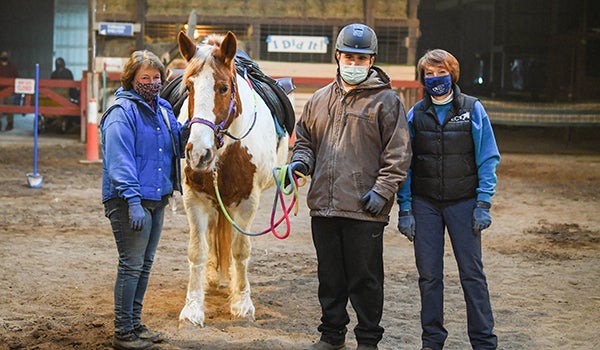Photography by Wes Jerdon/Westley Leon Studios
At halftime of Edwardsburg High School’s homecoming game in 2018, Ella Merrill stood on the football field among students nominated for homecoming court.
Ella looked like a normal teenager, wearing a classy, floor-length crimson gown draped with a sash announcing her nomination to homecoming court. When her name was called, she beamed ear to ear as a tiara was placed on top of her head.
Fans stood and clapped, some wiping away tears. Among the emotional were a group of EMTs.
“One of them came down and said the entire team that was first on the scene for her is here tonight,” said Heather Zile, Ella’s mother. “They came down to get a picture, and one of them said, ‘you know, I thought about you every day.’”
Underneath her crown, what Ella and her family refer to as a “silent injury” continues to make life challenging. Some days, a task as simple as counting to 10 seems like a feat. In spite of excelling in academics, tasks like these that she once took for granted are sometimes difficult now, as her brain continues to heal from her traumatic injury.
THE ACCIDENT
Ella has no memory of Dec. 13, 2017 — the day that changed her life — nor can she remember the 49 days that followed, testing her family’s faith as she lay in a coma in Grand Rapids. Her mom, however, expects she will never forget that time.
“She left somewhere around 4:25 p.m. to go to work in Elkhart,” Heather recalls of Dec. 13. “We said our goodbyes like normal and I was watching out the window. … I was waiting for my husband to come home and I was kind of watching the weather because it was getting really bad, so I saw the ambulance go by on Elkhart Road, and I remember saying, ‘ugh. That just makes me sick on a day like this — on the first snow.’”
A quarter-mile down the road, Ella had lost control of her vehicle due to the snowy conditions and spun out in front of a school bus. The bus, which emergency officials said had nowhere to go but straight with seven students on board, struck Ella’s car.
Meanwhile, Heather and her husband headed out for an event.
“When we went to leave the subdivision, my husband said, ‘I got rerouted because there was an accident, so you better go to the right,’” Heather says.
To the left, emergency personnel were headed to the site of Ella’s crash, preparing to take her to Elkhart General Hospital.
“Physically I was fine. I had a little scratch above my temple,” Ella says. “But my brain had gotten jarred badly.”
A SILENT INJURY
Ella had the worst brain injury a person can have: a diffuse axonal injury which Heather explains “literally pulls everything apart inside the brain.”
BrainandSpinalCord.org reports that diffuse axonal injuries are not the result of a blow to the head, but of a jarring like Ella experienced, during which the brain moves back and forth inside the skull. The injury is most often the result of automobile accidents like Ella’s, sports-related accidents, violence, falls or Shaken Baby Syndrome.
According to the same site’s research, about 90 percent of survivors with severe diffuse axonal injury remain unconscious. The 10 percent who do regain consciousness are often severely impaired.
After the accident, Ella was transported to Helen DeVos Children’s Hospital in Grand Rapids, and later to Mary Free Bed Rehabilitation Hospital, where Heather and her family would learn how to take care of their daughter, who doctors said would more than likely live the rest of her life in a vegetative state.
Heather’s faith told her Ella would be the exception.
“There were times I was challenged by physicians as to whether I understood what they were saying based on my response, and I would say, ‘sadly I do understand,’” Heather says. “But there is a space outside of medical diagnosis that you know is God’s space, because everyone would say brain injury is unpredictable. So I said, ‘let’s just see.’”
For nearly two months, Ella’s family refused to cry in her hospital room, despite a rollercoaster of physical responses to the brain injury that included respiratory failure and increasingly grim diagnoses.
 “We chose to live with joy in that room every minute of the day,” Heather says. “Not that crying didn’t happen, but never in there, because you don’t know when someone is in a coma what they’re hearing or what they’re feeling and seeing.”
“We chose to live with joy in that room every minute of the day,” Heather says. “Not that crying didn’t happen, but never in there, because you don’t know when someone is in a coma what they’re hearing or what they’re feeling and seeing.”
Later on, one of Ella’s doctors would tell Ella, “your mom sure knows how to pray” because nearly 50 days after the accident, the teenager began showing signs of waking up.
RECOVERY
While changing her bedding one day, a nurse turned Ella’s body toward Heather, who noticed she was crying. Doctors warned her this was a normal response.
“For about 24 hours, she would just cry,” Heather says. “It would just be tears, not really an active cry.”
The next day, sitting in a wheelchair between her mom and her sister, Ella laughed at the punch line of the story her mom was telling. Doctors said it was coincidental.
“It was only maybe 24 hours later, one of the first times we’d ever had television on in her room,” Heather says. “Something happened on TV, and she laughed at the right time. I went running down the hall and I said, ‘no! Not twice!’”
Within a day, Ella’s eyes opened all the way, and doctors began backing off medication.
Though Ella’s memory is spotty for days before and months after the accident, she knows her mom was there when she woke up.
“I was still foggy, but I remember I was laying in my bed and my mom was sitting by me somewhere and I look over and I asked her why I was in there,” Ella says. “That’s my first memory.”
From that point on, Ella recovered quickly. Not long after waking up, she began engaging in conversation, ready to get started on physical therapy.
“She literally broke every record from that moment on,” Heather says. “Everything they predicted, she did it 100 times faster. … They would say, ‘we’re not even going to predict anymore.’”
Despite its rapidity, recovery was no easy feat. Ella had to learn to walk, talk, eat, swallow and process her thoughts, and she continues to relearn these fundamental behaviors.
“They had put a wheelchair ramp on our house,” thinking that Ella would never walk again, Heather says. “They said it was the only time that they ever put one on, and they had to remove it before we got home.”
MOVING FORWARD
On March 4, just 2018, just 81 days after the accident, Ella walked out of Mary Free Bed.
Hours later, dozens of community members lined M-62 holding signs and shouting cheers as a firetruck led a parade through the village of Edwardsburg. The grand entrance was an escort for Ella and her family, a celebration of the miracle that allowed the teenager to prove medicine wrong.
Today, Ella’s wit lights up conversation in her classes at Edwardsburg and an area community college, on the tennis court and socializing with family and friends.
She appears to love an audience, and delights at cracking jokes that make people wonder if they are allowed to laugh.
“Look at ‘Mean Girls,’ the movie,” she says a little over one year after returning home to Edwardsburg. “The Homecoming Queen was hit by a bus — and so was I!”
“People don’t know what to do with her with the bus stuff,” Heather says, shaking her head.
But Ella’s smile stretches wide across her face.
“It’s funny!” she says. “If you can’t laugh about it, what’s the point?”





